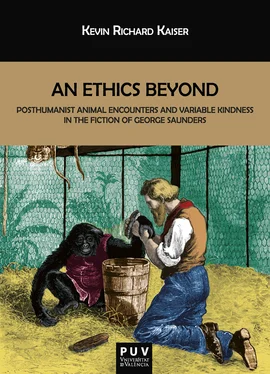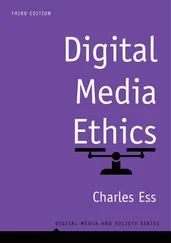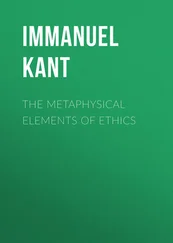Comparable to “Consider the Lobster” and indicative of Kaiser’s claims, Wallace’s opening sentence to the short story “The Depressed Person,” included in the short fiction collection Brief Interviews with Hideous Men (1999), begins “[t]he depressed person was in terrible and unceasing emotional pain, and the impossibility of sharing or articulating this pain was itself a component of the pain and a contributing factor in its essential horror” (37). Here, it is difficult not to equate Wallace’s own struggle with depression with that of the character, but instead of generalizing depression, the protagonist’s depression is particular. By the end of the story, her therapist’s death has left her questioning her capacity for compassion. Wallace does not moralize but instead presents an ethically complex scenario. As I will evince later, Saunders’s writing also functions in this way: it presents ethically complex situations without any decisive moral.
In a different vein, the first chapter of Wallace’s Infinite Jest (1996) describes the movements and speech of Hal, a tennis prodigy. The administration comments upon his movements and speech:
‘But the sounds he made.’
‘Undescribable.’
‘Like an animal.’
‘Subanimalistic noises and sounds.’
‘Nor let’s not forget the gestures .’
‘Have you ever gotten help for this boy Dr. Tavis?’
‘Like some sort of animal with something in its mouth.’
‘This boy is damaged.’
‘Like a stick of butter being hit with a mallet.’
‘A writhing animal with a knife in its eye.’ (14)
The sounds Hal makes are later compared with those of a drowning goat, his sounds and actions barely mammalian. He is both compared to an animal, in a derogatory sense, and considered less than animal (subanimalistic) before being compared with an object made from the bodily fluids of an animal (butter). The focus is on the sounds and gestures that are Hal’s (attempts at) language. In his essay, Kaiser conjectures that Hal’s transformation “from a superb human specimen, a remarkable athlete and mental prodigy, to something” animalistic is an instance of “becoming-animal,” as proposed by Gilles Deleuze and Félix Guattari (57). Hal’s “pain, travels through neural and physiological networks that are no longer human” (Kaiser 57-58). Saunders’s characters generally do not undergo such transformations, but the relationships between human and nonhuman animals appear with greater frequency, even if only in passing. Furthermore, he alludes to them almost exclusively in terms of violence and death. I explore this relationship in some fashion in the chapters to follow.
“An Inherently Ethical Activity”: Reading Saunders Critically
Until recently, the critical analysis of Saunders has been rather thin, with the appearance of only a few academic essays—upon which I will comment later in this chapter—and a series of interviews and book reviews. However, in 2017, the first collection of critical essays on the author finally was published. The scholarly work examines Saunders’s writing from a variety of angles—linguistic, sociopolitical, biopolitical, psychological, and even theological—making George Saunders: Critical Essays a landmark collection in Saunders criticism. The collection includes an essay by Adam Kelly, who—following his earlier essay on New Sincerity—directly addresses Saunders’s fiction in terms of New Sincerity. In “Language Between Lyricism and Corporatism: George Saunders’s New Sincerity,” he notes how Saunders’s “use of first-person narration supports his New Sincerity aesthetic, allowing him to explore the limits of expressive subjectivity, ethical consciousness, and detached spectatorship under neoliberal conditions” (49). Even Saunders’s third-person narration, which I will address in a later chapter, reads like first-person narration.
Most of the information on Saunders is still found in interviews and book reviews. As the first monograph on the author, this book aims to provide a sustained analysis of Saunders’s fiction, primarily exploring posthumanist ethics as they relate to nonhuman and human animal relationships in Saunders’s texts. As this study is interdisciplinary, I believe it will be useful not only for understanding Saunders’s fiction but for understanding different conceptions of posthumanist ethics and how we relate to and with nonhuman animals.
Earlier, I compared David Foster Wallace’s writing with that of Saunders. Likewise, John C. Hawkins’s Liberty University Master’s thesis, Life Inside the Spectacle: David Foster Wallace, George Saunders, and Storytelling in the Age of Entertainment (2013), offers an insightful reading of and commentary on Saunders’s In Persuasion Nation alongside Infinite Jest . He argues that both books “confront the problems of isolation and dehumanization created by entertainment-based consumerism” (Hawkins 4) and especially notes Saunders’s idiosyncratic language and use of first-person and close third-person narrators. Like Hawkins, Laura Morris also compares a contemporary author with Saunders in “Beyond Irony: Reconsidering the Post-Postmodernism of George Saunders and Dave Eggers” (2016). She focuses on how the narratives of both authors demonstrate a “recent literary development” that centers “on new possibilities of sincerity in order to transcend postmodernism’s use of self-reflexive irony” (Morris 117). Her critical stance is, for all purposes, nearly equivalent to that of Adam Kelly’s concept of New Sincerity, except that she draws on the philosophy of Jacques Rancière to make her point. Like Kelly, Hawkins, and Morris, most critics of Saunders examine his writing in terms of recent cultural and social criticisms, often by exploring how language functions in his texts or how ethical situations are presented, yet their approaches are quite varied.
Two studies on class are found in essays by Juliana Nalerio and David P. Rando. Juliana Nalerio’s essay, “The Patriarch’s Balls: Class Consciousness, Violence, and Dystopia in George Saunders’s Vision of Contemporary America,” offers a critical reading of “The Semplica Girl Diaries,” analyzing class anxiety and “the latent violence inherent in America’s post-colonial capitalist system,” as well as the techniques Saunders uses to expose violence (2015, 90). David P. Rando also considers class in his essay “George Saunders and the Postmodern Working Class,” which describes how Saunders’s story “Sea Oak” and his fiction in general challenges readers “to reconsider basic questions of class representation” (2012, 437).
Critics also have commented on Saunders’s fictional worlds. In a politically charged reading, “Changes in Totalitarianism: Hannah Arendt, Franz Fühmann, and George Saunders,” Todd Cesaratto investigates how “the structure and semantics of totalitarian organization have changed” and adapted to “power-sharing” social structures (2011, 74). He compares the totalitarianism found in both the socialist system of Franz Fühmann’s “Der Haufen” and the capitalist, hyperconsumer cultural setting of Saunders’s “My Flamboyant Grandson.” The effects of a hyperconsumer totalitarian technoculture also are examined in Gil Germain’s “‘It’s Not Yours to Do With What You Like!’ A Critical Reading of George Saunders’ Jon” (2014). Germain notes “how Saunders uses language to underscore the general point that there is no strict separation between our inner thoughts and feelings [...] and the world with which we interact” (n.p.). We learn much about the worlds where Saunders’s characters exist, which are like caricatures of our own, based on how the characters speak, think, and interact with their surroundings.
Читать дальше












